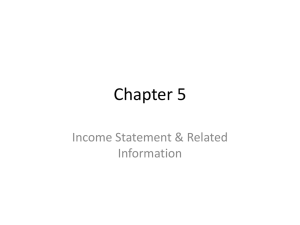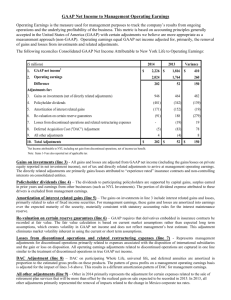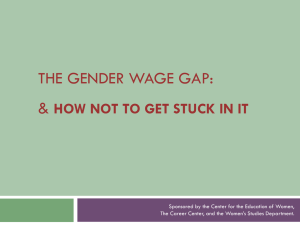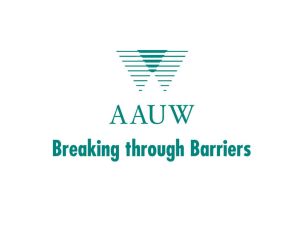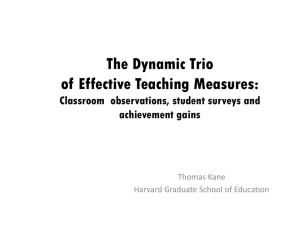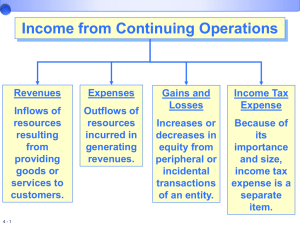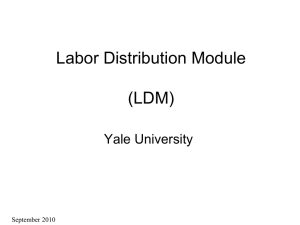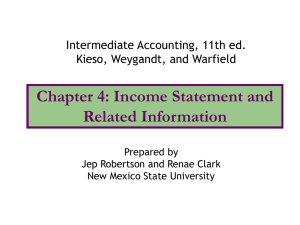Your Nonprofit is Worth More Than You Think
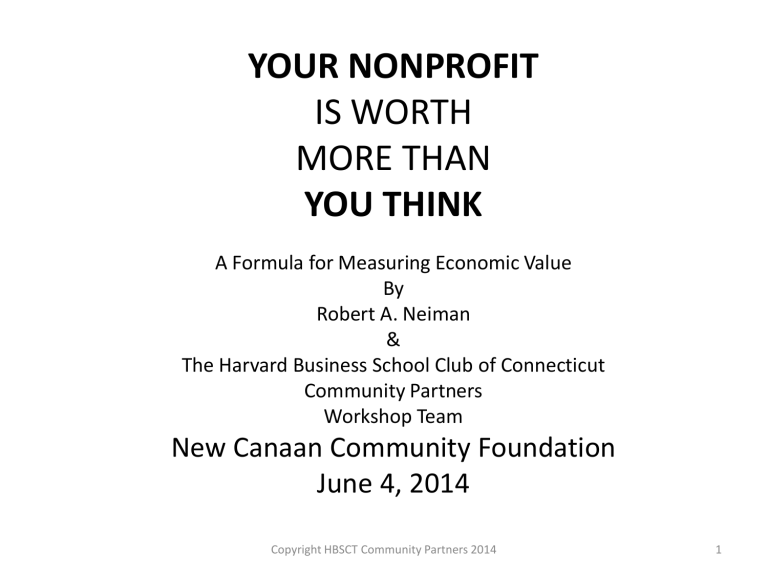
YOUR NONPROFIT
IS WORTH
MORE THAN
YOU THINK
A Formula for Measuring Economic Value
By
Robert A. Neiman
&
The Harvard Business School Club of Connecticut
Community Partners
Workshop Team
New Canaan Community Foundation
June 4, 2014
Copyright HBSCT Community Partners 2014 1
A Principle
“….There is only one valid definition of the value of an enterprise. It is the value experienced by the customer…”
Peter Drucker (Approximate quote)
Copyright HBSCT Community Partners 2014 2
How Do We Typically Define the Value of a Nonprofit Organization?
In Providers Terms
• The need it addresses
• The people it helps
• The money it spends
• Number of clients served
• Number of offerings
• Number of attendees
• Dollars raised
• Years it has existed
• Affiliations it has
In Beneficiaries Terms
Pain alleviated
Poverty relieved
Ignorance overcome
Disabilities overcome
Inspiration gained
Abuse eliminated
Earnings gained
Social connections created
Success in life
Copyright HBSCT Community Partners 2014 3
But there is more:
Economic Value!
Copyright HBSCT Community Partners 2014 4
A Simple Way
Which is the more persuasive proposition?
• “We help 1,000 families a year by providing emergency food and clothing,” or
• “We make a $5mm/yr difference in our community
INCOME by helping 1,000 families stay together and pursue jobs and schooling through counseling and emergency donations of food and clothing.”
Copyright HBSCT Community Partners 2014 5
“AREAS OF FOCUS” OUTLINED BY TOM RALSER
(ROI FOR NONPROFITS)
Value of an organization as an entity (salaries, supplies, rent, etc.)
Service delivery impact
Social costs avoided
Ralser Advocates:
Investment Orientation
Vs. Charity Orientation
Maybe 10% of NFP’s do this
Societal outcomes enhanced
Business growth from economic development campaigns
Sum it up: Total Economic Impact
Copyright HBSCT Community Partners 2014 6
ROBINHOOD FOUNDATION APPROACH*
1. Adopt a mission statement
2. Translate the mission statement into well defined goals
3. Identify a specific intervention to analyze
4. Identify each and every mission relevant outcome that derives from the intervention
5. Monetize – assign a dollar value to each outcome above
6. Estimate the benefit/cost ratio of the intervention
7. Compare the benefit/cost ratio of one proposal to another
* Rules for Smart Giving . Weinstein and Braburd. Published by Columbia Business School
Copyright HBSCT Community Partners 2014 7
How Can We Measure Economic Value?
“…Let Me Count the Ways…” *
• Cost Effectiveness (CES)
• Cost/Benefit Analysis
(CBA)
• Social Return on
Investment (SROI)
• Robinhood Foundation
Benefit/Cost ratio
• Acumen Fund BACO Ratio
• Hewlett Foundation
Expected Return
• Ctr. For High Impact
Philanthropy Cost per Impact
• Foundation Investment
Bubble Chart
*Gates Foundation: Summary
Copyright HBSCT Community Partners 2014 8
Value Measurement Map
Inputs
People Money
Expertise Facilities
Tools Passion
Operations
• Programs
• Services
• Products
• Experiences
Outputs
Shelter Beds Provided Meals Delivered
Health Clinic Caseload Counseling Sessions Conducted
Children Tutored Concerts/Exhibits Held
Copyright HBSCT Community Partners 2014
Outcomes/Benefits
(Economic/Social)
•
Reduced Homelessness
• Improved Health
• Reduced Crime/Domestic
Violence
• Higher Student Grades and
Graduation Rates
• Increased Employment/Income
• Better Community Quality of Life
9
Case Example: Employment
1. Define the initial economic condition (e.g. earnings of participants – the prime clients – at the start of the program.)
2. Calculate their incremental economic gain resulting from the program at the end.
Copyright HBSCT Community Partners 2014 10
CASE EXAMPLE:
EMPLOYMENT/INCOME
• The initial condition for job seekers is “zero income”
• The change after 6 months: 70 of 100 have jobs with average salary of $30,000 pre-tax. That is the outcome.
• After one year of sustained employment: 70x$30,000
= $2,100,000 cumulative pre-tax gain for participants for one year
• Cost of program = $500,000
Copyright HBSCT Community Partners 2014 11
Economic outcomes
Economic Value
Inputs
Cost/Investment to Produce
Outcome
Benefits
Economic
Value
Copyright HBSCT Community Partners 2014 12
Benefits
Economic
Outcomes
Benefit/Cost Ratio
Cost
Input to Produce
Benefits
Benefit /
Cost
Ratio
Copyright HBSCT Community Partners 2014 13
ECONOMIC VALUE AND COST/BENEFIT
CASE EXAMPLE
Economic Value Amount
• Net Economic Value Created = $1,768 + $245K
• $2,122KN - $608K = $1,514K or $1.5illionN
Value/Cost Ratio for first year
$1,600,000 / $500,000 = 3.2X
Note: tax effects, collateral and induced benefits, and longer term compounding effects are ignored for simplicity. These would tend to further enhance value.
Copyright HBSCT Community Partners 2014 14
ADDITIONAL BENEFITS
• Agency earned $140,000
• Communication agencies earned $20,000 for their work
• Trainers and contract suppliers earned $180,000
• Employers gained $160,000 in subsidies + good employees who in turn created value
• Communities gained from the induced spending of the newly employed and reduction of costs of dysfunctional behavior
• The government sees increased tax revenue and decreased support costs – “social cost avoidance”
Total Benefit is the sum of all these gains
Copyright HBSCT Community Partners 2014 15
CRITICAL POINTS
• Match Benefits with Costs
– “Cause and Effect” Linkages
– Corresponding Timeframes
– Consistency and Simplicity
• Credibility will be Maximized by Regular Measurement,
Tracking and Reporting of Value
• Do Calculations Relevant to an Audience, e.g.
– Participants: Direct benefit (individual gain)
– Funders: Benefit – Cost = Economic Value amount or
Value/Cost Ratio
– State or Community: add societal cost reductions, collateral and induced gains to get total economic value
• Do no more calculations than you’ll be using
Copyright HBSCT Community Partners 2014 16
Do You Want Your Grantees to
Report Economic Value?
• Build it into your grant request form
• Help them respond
– Consultation
– Workshops
• Keep track of your grantees results. Your funders may want to know.
Copyright HBSCT Community Partners 2014 17
ECONOMIC VALUE FOR
EIGHT ORGANIZATIONS IN FAIRFIELD COUNTY CT. IN 2013
ORGANIZATION
Abilis
PROGRAM
Birth-3 yr. old
Special needs children
Catholic Charities
Food Program
Housing
Development Fund
Inspirica
Soup Kitchen for all in need
First time buyer program
Women’s Shelter
Neighbor to
Neighbor
Shelter for
Homeless
TBICO
The Bridge to Independence and Career Opportunity
TSTT
Teachers
Food service
Emergency Shelter
Employment service
Education support for students to become teachers
$ ECONOMIC VALUE
X RETURN ON COST RATIO
$5,678,357
2.3X
$1,400,000
2.0X
$11,012,000
7.9X
$13,556,605
38.3X
$1,700,000
6.6X
$8,800,000
4X
$1,977,000
5.9X
$5,163,766
6.1X
18
Inspirica: Value to client based on tracked earnings, plus new State supplement, minus housing costs. Plus the value to the community based on studies of health, policing and other community cost reductions as homelessness is reduced. Plus benefits to local businesses, based on studies in similar communities. Plus tax benefits to the State based on the incremental tax effect of earnings of retail businesses.
RITE program: Actual tracked earnings gains of clients; plus actual tracked declines in State supplements to clients. Governmental support savings based on actual tracked values including
Medicaid components based on State averages of Medicaid costs.
Housing Development Fund: Decreased credit costs to homeowners; plus gains to municipality, banks and servicers; plus increased tangible wealth accruing to homeowners; seven year residency; thirty year mortgage.
Abilis: Reduced cost of special education and other support costs based on State estimates of value accruing to families and governments because of early childhood education for special needs children. Long term gains were discounted to present value in order to compare to the present value of shorter term cost of the early childhood
TSTT: The long term yield and earnings of teachers emerging from the TSTT support program were discounted to the present value at start to compare to the present value of the earlier but extended investment in high school and college education.
Others were based on more direct one year savings to clients based on retail costs of food and other services and induced benefits to communities.
Copyright HBSCT Community Partners 2014 19
QUESTIONS/DISCUSSION
Copyright HBSCT Community Partners 2014 20



